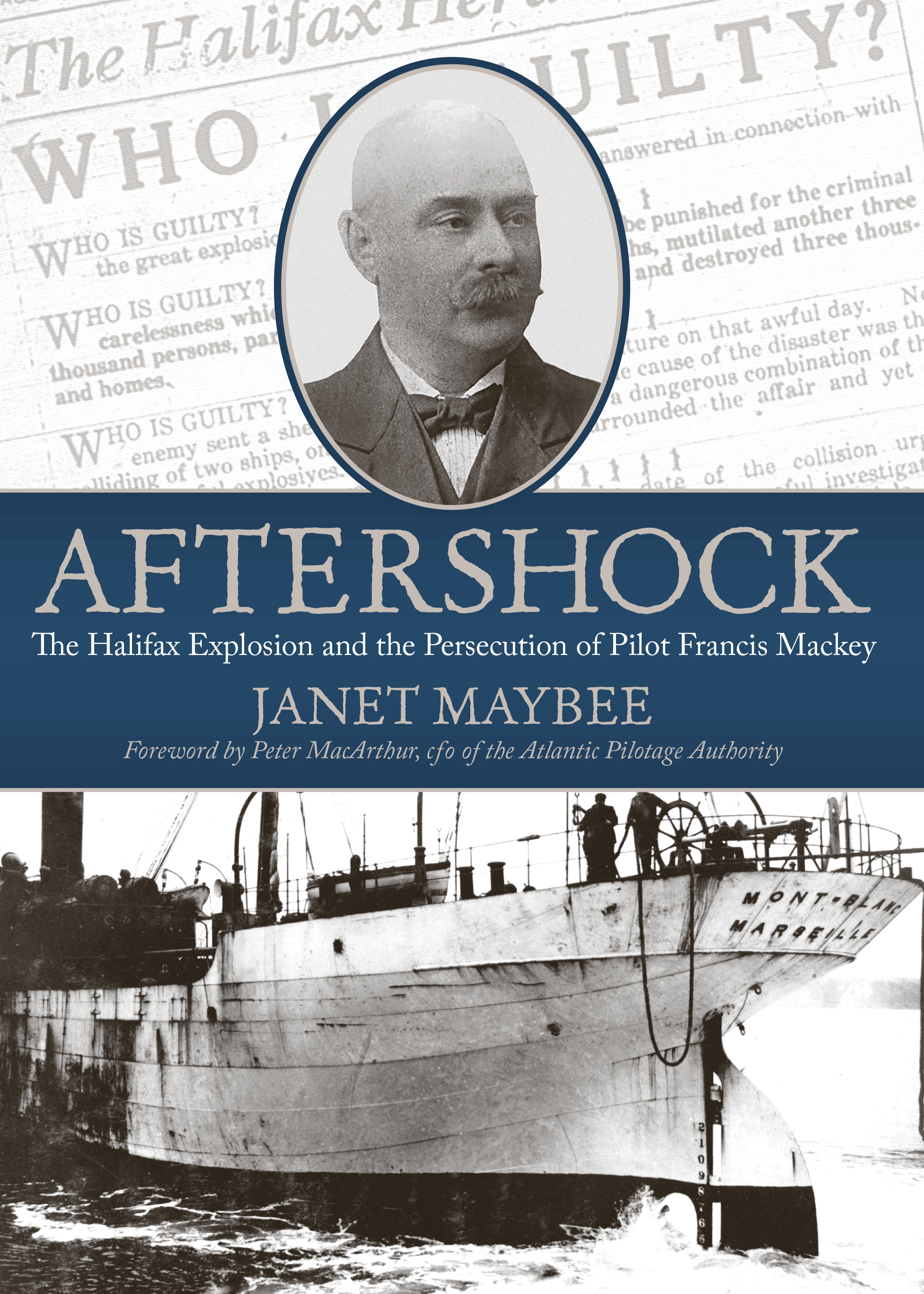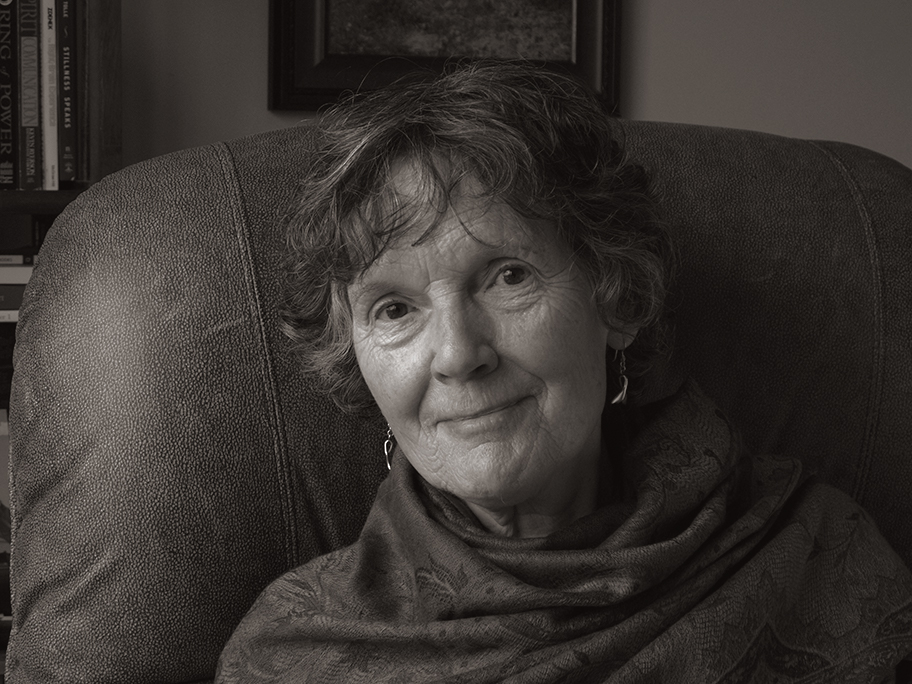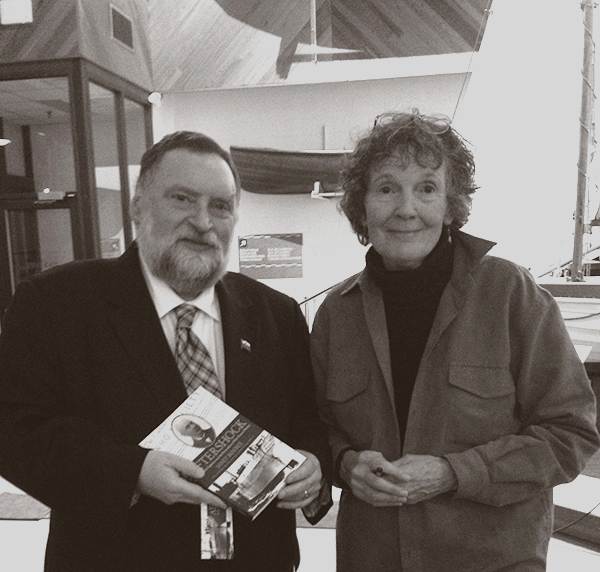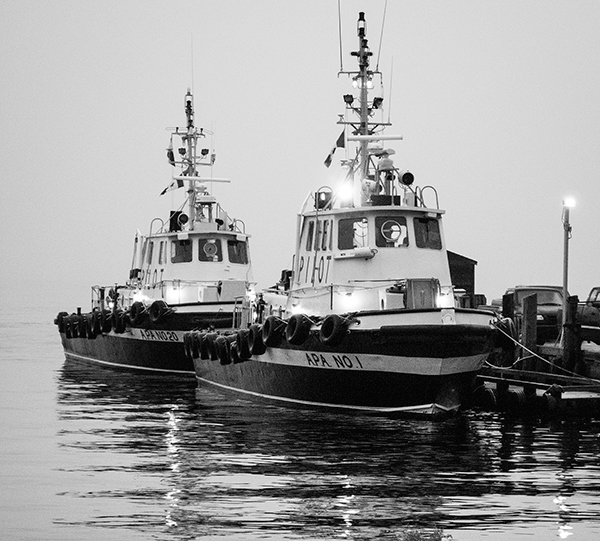"In Aftershock, Janet Maybee sets out to tell the true story of Francis Mackey, the pilot of the Mont Blanc, who has too often been held responsible for the tragic Halifax Explosion on December 6, 1917. With considerable zest and passion, Maybee explores the reasons for Mackey's persecution at the time and thereafter the denial of his pilot's licence, the lingering effects on him and his family, and the many attempts to restore his reputation. Aftershock often reads like a fine detective story."
Gerald Hallowell
retired senior editor, Canadian history, at University of Toronto Press; editor of The Oxford Companion to Canadian History (2004); author of The August Gales, Nimbus 2013.
"Would we all be so fortunate, one hundred years from now, to have such a knowledgeable and passionate advocate, as Janet Maybee is for Francis Mackey. With a solid foundation of ground-breaking research, a keen curiosity to uncover the truth, a clear dedication to justice, a compassionate humanity fully engaged, and an eloquent prose style (with wit firmly in place), Janet Maybee has succeeded admirably in what she promised Francis Mackey’s daughter: she has told his story clearly and has unequivocally shown that he was not to blame for what happened in Halifax on 6 December 1917. Indeed, he did all he could to avoid the tragic outcome.
In the telling of Mackey’s story, woven with the story of her own discovery of it and pursuit to understand it better, Janet Maybee has also demonstrated how the past is never “then” – but continues to be part, a vital part, of “now.” Aftershock is a fascinating, deeply moving and profoundly instructive narrative that must bring us all to the sobering realization that the more things change, the more they stay the same; and the questions asked, or not asked, about the causes of the Halifax Explosion are still eerily relevant today.
By learning more about Mackey as a person and harbour pilot, hearing from his descendents about the impact of these events on their lives, Janet Maybee gives us emotional and psychological layers that almost always are ignored in the “sound byte” society in which we live. The catastrophic physical damage of the explosion has always received primary attention, and rightly so; but by reading the story of harbour pilot Francis Mackey, we learn so much more about the intimacies and consequences of this event and how its impact has rippled out in time.
"
Sandra Barry
is a poet, independent scholar and freelance editor. She has written extensively on literary and historical subjects, including Elizabeth Bishop: Nova Scotia’s Homemade Poet (Nimbus).
"Janet Maybee has unquestionably restored the public honour of the Mackey
family for all time. But never were they at all without decency, humanity
and honour. Janet Maybee has the academic background to produce learned
narratives and she does that here. But this is "Janet unplugged," and she is
scathing in her denouncement of those who kept the censure and controversy
going on and on long after Mackey and the other two charged had been
cleared by the courts. Indeed, Mackey was characterized in a very negative
slovenly way as late as a Canadian 2003 television movie, even after an academic study had determined the accused were victims and in no way culpable."
John Griffith Armstrong
Author of The Halifax Explosion and the Royal Canadian Navy : Inquiry and Intrigue. UBC Press 2002.
"In Aftershock Janet Maybee has presented a facet of the Halifax
Explosion not hitherto much explored, namely the apportioning of blame
for the catastrophe. To say she has discovered the man who became its
scapegoat is to diminish the effect of this book, for it reads almost
like a thriller: its clarity, detail, supporting documentation, and
illustrations are all couched in prose that is a joy to read.
Several years ago the author came into possession of a house in
Halifax's north end that unbeknownst to her had been in the family of
her subject, Francis Mackey. Mackey was the harbour pilot in charge of
the Mont Blanc and its death-dealing cargo on that December morning
almost one hundred years ago. Intrigued by this connection, she began
seven years of research that have resulted in this excellent account
of the pilot’s perspective on what actually happened, the subsequent arrest and imprisonment of Mackey,
and the ongoing misinformation that still tarnishes his name and reputation.
Reading this riveting account of what was clearly a miscarriage of
justice, one is grateful that Maybee accomplished her task when she
did, for she was able to interview some of Mackey's relatives who
provided invaluable information and have subsequently passed on. That
her book squeaks in before the 100th anniversary of the explosion is
also fortunate: her exhortation to readers to refute claims of
Mackey's guilt that are bound to surface come December 2017 is most
compelling. Part of the "aftershock" of reading her account is
realizing that for nearly a century he has been maligned. This book
rights a dreadful wrong: it is difficult to imagine a more able
champion of the stoic Francis Mackey than Janet Maybee.
Having myself done research into matters arising from the explosion
when I was writing a book on Archibald MacMechan, the Dalhousie
professor tasked by a Halifax newspaper to compile an account of the
explosion in its immediate aftermath, Maybee's book is of particular
interest. Two of MacMechan's daughters, whom I interviewed in the
early 1970's, were adamant that their father puzzled over and was
deeply hurt by an unanswered question for the remainder of his life:
his quite substantial collection of information amassed through his
interviews with survivors and his first-hand observation of the
devastated city through which he assiduously walked was shelved and
never published as had been the understanding when he undertook the
project. The office he had been assigned at the newspaper was
summarily closed to him. He was never given a reason. This detail
leapt to mind as I read Maybee's book, and it suddenly seemed more
significant and more sinister. Why, indeed.
"
Dr. Janet Baker
retired professor of English at Saint Mary’s University, author of Archibald MacMechan, Canadian Man of Letters, Roseway Publishing, 2000.
NEW BOOK SAYS PILOT FRANCIS MACKEY WAS SCAPEGOAT
FOR HALIFAX EXPLOSION
How would you like to be remembered as the person responsible for a disaster that destroyed half a city, killed 2,000 people and left another 12,000 injured?
Such is the case of Francis Mackey, the Halifax Harbour pilot who was aboard the French munitions ship Mont Blanc on the morning of Dec. 6, 1917, when it collided with the Norwegian ship Imo. Mr. Mackey was able to escape the fire and explosion that destroyed much of Halifax and Dartmouth, but his actions in those crucial moments before the collision became the focus of the investigation. Even though he was confident he had done everything right, Mr. Mackey became embroiled in a legal nightmare. He lost his pilot’s licence, was charged with manslaughter and became the target of anger in the court and in the press. He was eventually cleared of the charges and fought to get his licence back, but a Halifax author says Mr. Mackey and his family were never able to shake the perception that he was responsible for one of the most devastating disasters in Canadian history.
And now, nearly 100 years after the Halifax Explosion, author Janet Maybee is crusading to clear Mr. Mackey’s name. In a new book called Aftershock: The Halifax Explosion and the Persecution of Pilot Francis Mackey (Nimbus Publishing) the author seeks to change history’s perception of Mr. Mackey.
“The real villain was the war itself,” Ms. Maybee told me last week. “That ship should never have been allowed to come into the port in the first place.”
Perhaps if he had been killed too, he might have been remembered as a hero. But because he survived, he was forced to stand before the courts and society and take the blame. And as the story of the two ships colliding in the harbour is told and re-told in books, movies and on the Internet, Mr. Mackey is portrayed as a bumbling fool who abandoned the ship and ran away.
Ms. Maybee admits she has become rather obsessed with Mr. Mackey’s story. She was obviously familiar with the story of the Halifax Explosion, but it took on a new meaning when she purchased a house on Cabot Street in Halifax that had been damaged in the explosion and repaired. But upon further investigation, she found out that the house had been occupied by Mr. Mackey’s widow after he died in 1961. She got to talking with Mr. Mackey’s friends and relatives, including one of his daughters. From there, she embarked on a major research project in Halifax and Ottawa, poring through old records and information previously withheld from public view. The result was “The Persecution of Pilot Mackey “ for Northern Mariner, the journal of the Canadian Nautical Research Society. From there, she decided to turn her research paper into a book. The 130-page paperback contains many photos of Mr. Mackey, his family and the devastation of the Halifax Explosion. There are also maps that detail what happened on that morning of Dec. 6, 1917.
Mackey was confident that he had done everything he could, but the politicians, ship owners, the justice system, surviving victims and the newspapers were looking for someone to blame.
After an Inquiry, Mr. Mackey was charged with manslaughter and his pilot’s licence was revoked. The charges were later dropped and he eventually got his licence back, but he was never compensated for four years’ lost pay. He stayed in Halifax until his death in 1961, living with the horrible memories of that fateful day and carrying the weight of blame on his shoulders.
Ms. Maybee is hopeful her book will shed new light on Mr. Mackey’s tale and how a respected man was blamed for disaster, mainly because he managed to survive it.
Alan Cochrane
Moncton Times & Transcript, December 1, 2015.
"It’s a rare occasion when an author is able to use a book as a tool to right a historic wrong. But this is what Janet Maybee has set out to do in her new book, Aftershock: The Halifax Explosion and the Persecution of Pilot Francis Mackey.
A research associate at the Museum of the Atlantic, Maybee contends that the man who was blamed for the terrible 1917 explosion -- which killed and injured thousands and leveled entire swaths of the city -- was wrongly persecuted and vilified in the wake of the tragedy. Maybee accuses officials of the day of ignoring and even covering up key facts of the tragic accident, which saw a French munitions ship and a Belgian relief vessel collide in Halifax harbour, resulting in what was, at the time, the largest ever man-made explosion.
The author conducted many interviews with the family of Francis Mackey, the harbour pilot blamed for the disaster. She also mined the family’s personal archives for never-before-seen photographs that along with historic images and unique maps, place the Halifax explosion in a very human context.
This book is certainly worth reading for anyone who is interested in a fresh angle on one of Canada’s worst disasters."
Mark Collin Reid
editor, Canada’s History Magazine
Click here to read another review
from The Miramichi Reader
Click here to read an excerpt from the
book as printed in Halifax Magazine



